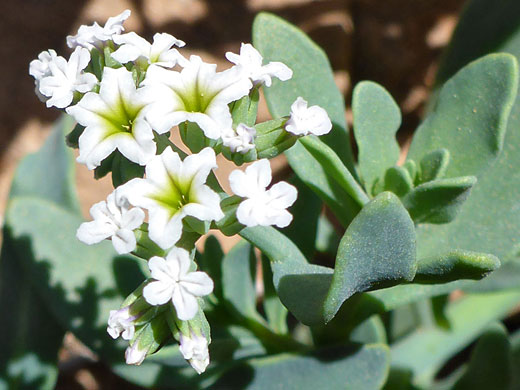Heliotropium Curassavicum, Salt Heliotrope
Plants > Wildflowers > Boraginaceae > Heliotropium Curassavicum

Compact cluster of white flowers; heliotropium curassavicum, Ash Meadows National Wildlife Refuge, Nevada
Common names:
Salt heliotrope, seaside heliotrope
Family:
Scientific name:
Heliotropium curassavicum
Main flower color:
Range:
All the western states, especially desert and coastal areas
Height:
Up to 2 feet
Habitat:
Salty and alkaline locations, often riparian, from sea level to 7,000 feet
Leaves:
Alternate, cauline, oblanceolate, grey-green, up to 2.3 inches long
Season:
February to October
Heliotropium curassavicum inhabits alkaline or saline environments, generally close to water sources. Flowers are produced in a coiled cluster which lengthens and straightens as they mature; there are between two and four clusters per stem. Flowers have a bell-shaped, five-lobed corolla, mostly white but yellow-green or pale purple at the base, beneath which is a dull green, deeply five-lobed calyx. Stamens are included, held well below the top of the corolla.
Leaves are thick and fleshy, essentially stalkless, and like the flower stems, are grey-green or slightly bluish in color, and hairless. Leaf edges may be slightly undulating. Leaves grow all along the stems; those near the base are reduced in size.
Leaves are thick and fleshy, essentially stalkless, and like the flower stems, are grey-green or slightly bluish in color, and hairless. Leaf edges may be slightly undulating. Leaves grow all along the stems; those near the base are reduced in size.
All Contents © Copyright The American Southwest | Comments and Questions | Contribute | Site Map











